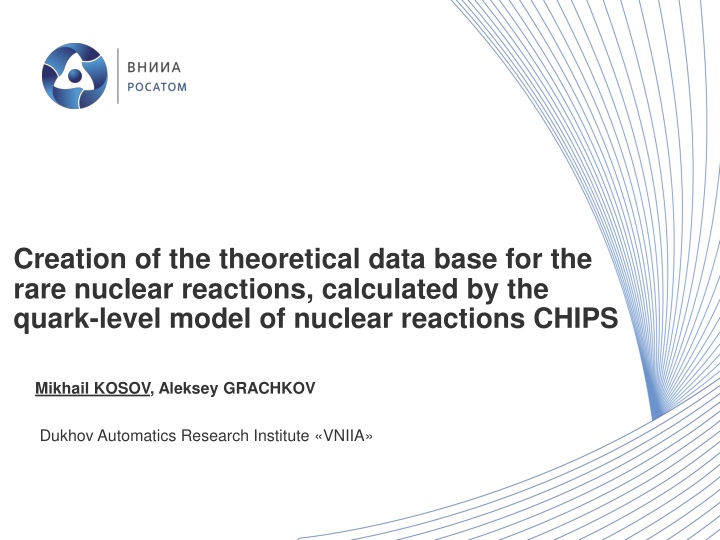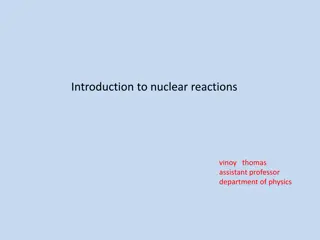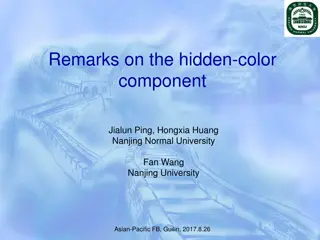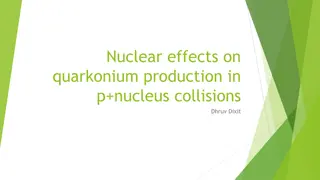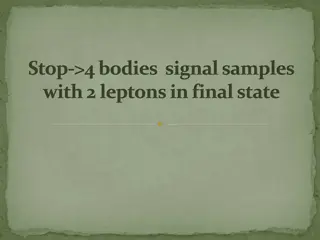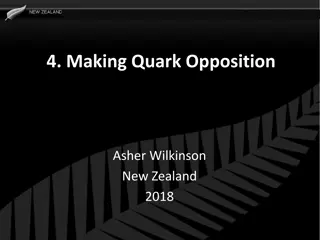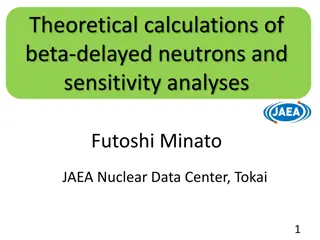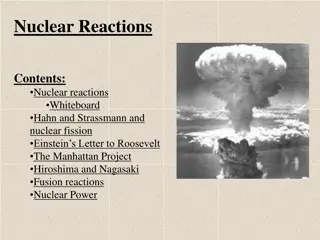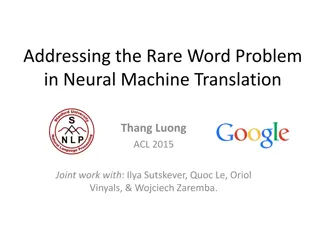Theoretical Data Base for Rare Nuclear Reactions Using Quark-Level Model
The creation of a theoretical data base for rare nuclear reactions using the CHIPS quark-level model is discussed in this research by Mikhail Kosov and Aleksey Grachkov from Dukhov Automatics Research Institute VNIIA. The study aims to predict cross-sections of unmeasured reactions, assess neutron-nuclear exclusive reactions, and model the behavior of nuclear fragments under various conditions. Additionally, the CHIPS algorithm for nuclear reactions and its implications on various nuclear processes are explored in detail.
Download Presentation

Please find below an Image/Link to download the presentation.
The content on the website is provided AS IS for your information and personal use only. It may not be sold, licensed, or shared on other websites without obtaining consent from the author.If you encounter any issues during the download, it is possible that the publisher has removed the file from their server.
You are allowed to download the files provided on this website for personal or commercial use, subject to the condition that they are used lawfully. All files are the property of their respective owners.
The content on the website is provided AS IS for your information and personal use only. It may not be sold, licensed, or shared on other websites without obtaining consent from the author.
E N D
Presentation Transcript
Creation of the theoretical data base for the rare nuclear reactions, calculated by the quark-level model of nuclear reactions CHIPS Mikhail KOSOV, Aleksey GRACHKOV Dukhov Automatics Research Institute VNIIA
Perspectives of the new theoretical data base for cross-sections of the nA reactions Prediction of the cross-sections of many rare nAreactions, which are not measured and can't be assessed by any empirical model with free parameters: the neutron-nuclear exclusive reaction cross-sections for rare isotope targets; the exclusive cross-sections of reactions with production of heavy nuclear fragments, which can significantly reduce radiation strength of nuclear materials; the anisotropy of differential multiplicities of the generated nuclear fragments. More accurate fit for the stopping power of the nuclear isotopes at low energy: generation of the speed distribution of the -radioactive nuclear fragments for more accurate simulation of the Doppler broadening of -lines in the measured -spectra; the bend gap factor in the stopping power of the low energy ions in insulators; the electron screening factor in the elastic ion-ion scattering cross-section. The theoretical data base for the unmeasured lifetimes of nuclear -transitions. the empirical fit for the measured 1, 1, 2, and 2 -transitions in nuclei; CHIPS modelling of the -radiation during the quark exchange between the excited nuclear cluster (Quasmon) and the cold nuclear clusters in nuclear reactions; quark-level calculation of the nuclear excited states and -transitions between them. 2
The quark-level CHIPS algorithm for nuclear reactions in flight and at rest _ _ Nonperturbative physical vacuum qq qq The Chiral Invariant Phase Space (CHIPS) model considers a nucleon as a ensemble of 3 massless quarks, surrounded by the physical vacuum with the boiling temperature . The physical vacuum separates clusters, which exchange quarks of the same color through it. The quark exchange through the vacuum barrier shifts exchanging N nucleons from their mass shells and bound them in clusters. The N-clusters can accumulate the external energy (Quasmon) by increasing a number of quarks n( ): Q (2n-1)Tc, n ( Q/Tc+1)/2. The nQuasmon (nQ) exchanges a quark of the energy k with the N-cluster quark , knocking out the corresponding nuclear fragment with mass MN, energy Tkin, and momentum p, then k=(Tkin+p)/2 q q Tc= 220.5 MeV _ _ q qq qq q q q q Quark exchange q q q q q q q q 3N-cluster q qq _ q 5Q-Quasmon 11 2.4 GeV MN E+ =MN+k p- =k { q q q q Q _ q q q q q q q k q Tkin=E-MN (E,p) hard hadronization: 3 k=(Tkin+p)/2
The most emphatic quark-level effects in nuclear reactions Pion multiplicity in the proton-antiproton and electron-positron annihilation Neutron spectra in pion capture at rest Anisotropy of the proton spectra in low energy photonuclear reactions at 60 MeV Neutron spectra in muon capture at rest Vacuum temperature and 1s hadron masses Annihilation "Thermometer" = 220.5 MeV Pion multiplicity increase with annihilation energy increasing evaporation Pion capture n Deep inelastic process Muon capture d p 600 181Ta 10 Geant4 -+p=n+ En=5 MeV 1500 data t 4He n 3He p 40 ( , )X 60 MeV The deep inelastic (quark-level) processes + the neutron evaporation. Production of heavy nuclear fragments. 4 The additional quark-level CHIPS processes: -+u d+ (m /2) - d+u+ (m )
Vacuum temperature in annihilation "Annihilation Thermometer" The pion multiplicity increases with the annihilation energy increasing = 220.5 MeV 2mN Tc(2nq-1) the smaller Tcthe more nq& n are. _ k q q (E,p) E=k+ p=k- k= (E+p) P. V. Degtyarenko, M. V. Kossov, H.-P. Wellisch, "CHIPS event generator I: Nucleon-antinucleon annihilation at rest", Eur. Phys. J. A 8, 217 (2000) 5
Pion capture fragmentation spectra Evaporation nonrelativistic PS 181Ta pion capture n d p Deep q-inelastic ultra-relativistic PS lnW Blokhintsev clusterization quasi-free NN P. V. Degtyarenko, M. V. Kossov, H.-P. Wellisch, "CHIPS II : -capture & A", EPJ A9,411, 2000 the kinematic 1 2 3 4 limit decay t 4He 3He CHIPS 6
Photonuclear reactions below (3,3) P. V. Degtyarenko, M. V. Kossov, H.-P. Wellisch, "CHIPS event generator III: Photo-nuclear reactions below ", Eur. Phys. J. A 9, 421 (2000) 40 ( , )X 60 MeV The unpublished paper of P.D.Harty was cited in PRC 49, 2704 (1994). Nobody could believe that 100 MeV gamma can accelerate the carbon nucleus so much (the boost of massless quarks). Even the nucleon- quasmon can't move so fast. The absorption of by the nucleon quark solves the problem. 600 900 1500 10 Quark absorption of q1 q2 Quarks are massless CHIPS P. D. Harty 7
Muon capture fragmentation spectra -+p=n+ En=5 MeV The T.E.O. Ericson's idea (e. a.,PRL, 69, 161, 1977): * n The additional quark- level CHIPS processes: -+u d+ (m /2) - d+u+ (m ) fit CHIPS p Data beyond the kinematic limit (?) M.V.Kossov,"CHIPS event generator: Nuclear muon capture at rest", Eur. Phys. J. A 33, 7 (2007) There are fragments too Geant4 background 8
CHIPS simulation of ion-ion interaction nucleus nucleon NA quasmon Q 1 GeV/fm quark rapidity QGS A Niedermaier string is split in nuclear and vacuum parts In the ion-ion interactions the Niedermaier string is split in the two nuclear parts and the vacuum part in-between. There can be a few quasmon-pairs creation in the collision. The multi-quasmon fragmentation algorithm is verified. AA Q Q The CHIPS ion-ion algorithm is a decay-algorithm. It is much faster than the cascade-algorithms of the other models (DPMJET, UrQMD, FRITIOF, VENUS). 9
Vacuum temperature Tc=220.5 MeV for calculation of 1s hadron masses The Tcdependence of the mass of n partons: M=2Tc n(n-1) Mesons spin products <s1,s2>= S(S+1)- ( +1)=+ - Mesons: M2=2Tc 2=624 MeV, (3m +m )/4=621 MeV Baryons spin products 2<s1,s2>= S(S+1)- ( +1)=+ - Baryons: M3=2Tc 6=1080 MeV, (mN+m )/2=1074 MeV The light quark hadron masses are published All 92 1s-hadron masses (be published) Masses of glueballs (f-mesons) without the color-magnetic shifts are close to M2, M3, M4=1528 MeV, M5=1972 MeV The Tccould be a third fundamental constant: E=Tc I (I=-S) M2 + - M3 + - N M.V.Kossov, EPJ, A14, 265 (2002) 10
The TPT algorithm for exclusive and inclusive cross-sections of reactions with production of nuclear fragments To normalize the differential multiplicity the inelastic cross-section inis used The CHIPS algorithm generates the final states of nuclear reactions, which can be sorted and collected for different exclusive channels of the nuclear reaction in a form of the 3N-histograms, where N is a number of the final state fragments with [px,py,pz]; Below the separation energies of the secondary fragments only the -excited residual nucleus can exist, so the "closest" -excitation level is selected, and the last decay in the fragment is recalculated with the corresponding fixed residual nucleus A* mass; To calculate the inclusive spectra of the identical fragments "i" all these fragments are collected to the common differential multiplicity histogram i(p)=dni/E/dp (ni=Ni/Mn), which can be converted to the invariant inclusive cross-section fi(p)= in i(p). The -decays of the excited nuclei are simulated by the -cascade tables RIPL The "closest" level choice for the CHIPS simulated nuclear excitations can be done, taking into account the width and the strength of the surrounding -excitation levels; The TPT models for the probabilities of the 1, 1, 2 2 -transitions are under development in the TPT software package to assess the unknown -transitions. The TPT stopping power solutions for simulation of the Doppler line broadening. For simulation of the -lines Doppler broadening the lifetime of the excited -levels and the stopping power of ions are necessary. The data provide knowledge of them. If the stopping power is known at low energies, one can find the lifetime? And if the lifetime is known, one can find the stopping power from the Doppler broadening form. 11
The TPT simulation of the -line Doppler broadening in the 16O(n, )13C reaction To slow down an ion only small steps can be used in the simulation, as the energy loss drops down significantly with energy decreasing. The first ion transport algorithm was realized in the gas approximation without any slowing down, but now the one step slowing down algorithm is used: 1. The TPT algorithm, taking into account the ion slowing down in the dt n reaction, was implemented in 2022. 2. The TPT low energy neutron elastic scattering algorithm for the logging simulation was implemented in 2023. 3. The 1-step slowing down algorithm for the -cascade was implemented in 2024 the resolution The experimental data The CHIPS cross-section for the 16O(n, )13C* reaction with the new 1-step 13C slowing down The CHIPS cross-section for the 16O(n, )13C* reaction, but in the gas approximation (wide) The adequate to the experimental data16O(n, )13C* reaction cross-section is absent in Geant4 NewtronHP and in the open data bases. For the TPT software package it was generated by the CHIPS model. The Doppler broadening of the -line depends on the lifetime (RIPL) and the stopping power dE/dx for the excited13C isotope in the BeO media (Geant4).The demonstrated experimental -spectrum (red dots) shows, that the line 3.686 MeV has two widths: the first one for the direct excitation (wide), and the second one is the result of the 167 keV -decay of the long lived 3.853 MeV level (narrow). The data are perfectly reproduced by the TPT simulation. 12
For comparison the Geant4 simulated -spectrum is shown The experimental data ? The Geant4 simulation results The simulation (gas approximation) ? 1. All the Geant4 spikes are narrow, so they correspond to the 13C decay at rest without any Doppler broadening. To the left of the 3.686 MeV line there is a dense set of lines, but this is not a Doppler effect, as to the right of the line there is no events. 2. Geant4 generates a lot of the strong spikes, which are not seen in the experiment, while they are much stronger than the lines, which are seen in the experiment. 13
Conclusion 1. The theoretical CHIPS data base can fill a gap in our knowledge of the neutron-nuclear reactions with production of heavy nuclear fragments. 2. The heavy fragments production, especially the -particle production (the helium pores), is very important for simulation of the radiation hardness of materials of nuclear setups and atomic power plants. 3. The energetic ions as a result of the material irradiated can be products of elastic and inelastic neutron-nuclear scattering and the induced ion cascade. 4. For ions knocked out of the crystal lattice and for ions produced in inelastic neutron-nuclear reactions the dE/dx function should be improved for the robust simulation of the ion cascades, especially for the low energy ions. 5. For the simulation improvement it is necessary to fit all IAEA experimental dE/dx data and measure the dE/dx functions at lowest energies. 6. The CHIPS model is validated at high energies, where the kinematic limits are not important, but at relatively low energies the new validation should be done, which can prove applicability of the quark level model al low energies. 7. We are looking forward to extend the CHIPS model beyond the projectile neutrons to the projectile -rays and other projectile nuclear fragments. 14
Thank you for your attention
The perspectives of the improvement of the dE/dx function from Geant4 to The black dotes are the IAEA data for the dE/dx function of Ti in different media. The data for Ti in Ti are absent. The TPT estimation is shown by the dashed line. The red markers of the same shape as the data correspond to Geant4. They are proportional to the ion speed (the LSS law). For the low energy ions the Geant4 fit is too far from the existing experimental data. One should vary the speed dependence. The Lindhard (LSS) ~ E ~v TiTi in Geant4 TPT fit Geant4 (?) The dE/dx values for Ti ions in gold are underestimated in Geant4 by a few orders of magnitude ? In our simulation we used the Geant4 fit of the dE/dx function, because as a result of the -decay the 13C* nucleus acquires relatively high speed, for which the Geant4 fit is close to the data. For the linear dE/dx it's much easier to calculate the step length to the 13C* decay. 16
Calculations of the step length to the nuclear decay and the nuclear speed If dE/dx= v, then m dv=C dx. If is the distance to the stopping poin( =0 v=0): m v=C x. If the decay time tdis known, one can calculate the distance to the decay d, which is passed during td. Substituting v=dx/dt, we get m dlnx=C dt relation, and it means that the slowing-down time ( =0, v=0) is infinite. If the radioactive ion was born at x=m v/C and decay after tdin the point xd, then m ln(x/xd)=C tdand xd=x exp(-C td/m). The step is L=x [1- exp(-C td/m)]. As xd=m vd/C, wher vdis the speed at the decay point, m ln(v/vd)=C td, and vd=v exp(-C td/m). If the stopping power is proportional to another power speed, then dE/dx=C v , where =1 is the LSS model. Then, substituting dx=v dt, we get m dv=C v dt or m dv1- =(1- )C dt, that is m v1- =(1- )C (t-t0). For <1 the slowing-down time ( =0, v=0, t0=0) is finite t=m v1- /(1- )/C. If td>t the nucleus manages to stop, but if td<t, it still has vd=[(t-td)(1- )C/m]1/(1- ), that is (without t) vd=[v1- -td(1- )C/m]1/(1- ). For >1, the same as for =1 (LSS), the slowing-down time is infinite and for any td: vd=[v1- +td( -1)C/m]1/(1- ). To get the step length L=x-xd, the speed should be integrated L= v(t)dt from 0 to td: L={[v1- +td( -1)C/m](2- )/(1- )-v2- } m/C/( -2). This formula is valid for any , except for the =1, but if <1 for td>t the step is restricted by the stopping point L=v2- m/C/(2- ). At this point the radioactive nuckeus is at rest, ad the -decay does not have any Doppler effect. One can see, that if 1the calculations are a bit more complicated, but the calculations of the step length to the nuclear decay and the nuclear speed at the decay point are still durable. 17
The fit of the experimental dE/dx values (IAEA) for different ions in gold The dotted lines LSS model The solid lines The light ions can be fitted by the LSS power =1, but the heavy ions definitely have >1. At high energies the common Bethe-Bloch law is a power law too. 18
